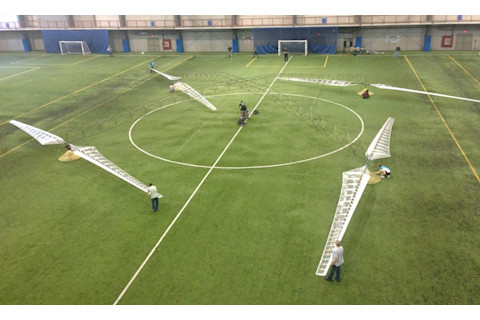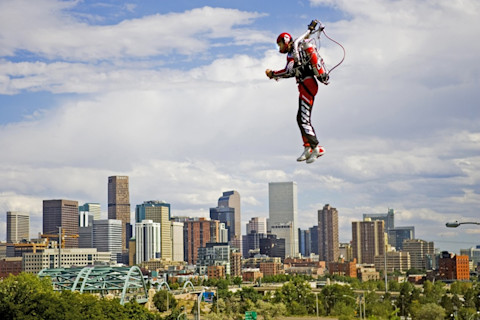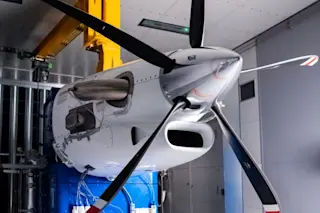How long have humans wished to fly? Likely from the moment hominins first gazed up at a bird and wondered How? Why?
Every subsequent civilization created myths, legends, gods and goddesses around flight. Flying dreams are a common part of the human experience. And although there is a universal desire to take wing, some cautionary tales emerged, too. In Western civilization, the Greek myth of Icarus is illuminating. Icarus’ father made two sets of wings consisting of feathers and wax so that he and his son could leave the island of Crete. The father warned his son not to fly too close to the ocean or the sun, but Icarus became giddy and carelessly soared too high. The sun melted the wax, and he fell into the sea.
Certainly, the Earth-bound folks who first built wings and strapped them on their arms understood the risks, but some gave it a try. The lucky ones never got off the ground, and those who launched from cliffs and promontories probably crashed and died.
It wasn’t until the 1400s that Leonardo da Vinci made serious, intellectual inquiries into flight. After studying the wing movements of birds, he drew machines resembling hang gliders, helicopters and parachutes. He grasped some understanding of aerodynamics, lift and the fluidity of air. However, his ideas remained fanciful and never left the drawing board.

AeroVelo’s Snowbird, the world’s first human-powered ornithopter. (Mike Campbell)
People wouldn’t actually take to the skies for another 300 years, when the Montgolfier brothers launched a hot air balloon at Versailles outside Paris. Benjamin Franklin, then serving as the U.S. ambassador to France, witnessed the launch and was stunned by the spectacle. Just two weeks later, an even better hydrogen balloon took to the skies and climbed thousands of feet.
A few decades later, Sir George Cayley, an Englishman who built models and gliders, was considered by many to be the first man to truly understand aeronautics, but the true glide master was Otto Lilienthal, an innovator through the late 19th century. This German pioneer added greatly to the science of flight and gave respectability to the idea of a heavier-than-air machine. He completed about 2,000 glider flights, but he fell from the sky on his last attempt and died. The Wright brothers thought him a genius and a hero.
It was the Wrights, of course, who in 1903 merged glider technology with the internal combustion engine and launched the race to see who could go the highest, fastest and farthest. Over the decades, flying has become normal, even unexciting. But some pioneers today still choose to avoid the routine and the safe. Their dream of flying doesn’t include pressurized cabins and first-class seats. It’s a dream powered by human effort, by wind or perhaps by a pack strapped to their backs.

The Atlas, before its world-record flight in 2013. (CKMM Photographic/AeroVelo)
Human-Powered Fliers When it comes to human-powered aircraft, bigger is better because human engines just don’t generate much power or speed. That was the challenge faced by AeroVelo, the Human Power Vehicle Team at the University of Toronto, as they attempted to win the famed Sikorsky Prize: a $250,000 award offered by the American Helicopter Society and Sikorsky Aircraft. To win, an individual or team must be the first to build a human-powered helicopter that could hover at least 3 meters off the ground for 60 seconds or longer in a 10-meter square. It sounds like a simple task, but the prize went unclaimed for more than 30 years. It was clear that any serious contender would need a massive helicopter to generate enough lift.
“It’s simple analysis and math. Bigger is more efficient, but bigger means more structural weight. There is a break point, or an optimum, past which going any bigger is unnecessary,” explains Cameron Robertson, chief structural designer at AeroVelo and co-founder.
The AeroVelo team, consisting largely of graduate students, built Atlas, a helicopter 154 feet across with four rotors, each blade about 33 feet in radius. Constructed of carbon fiber tubes, Mylar, polystyrene foam, balsa wood and synthetic cord, Atlas weighed roughly 122 pounds.
Power came from the legs of Todd Reichert, an elite cyclist and speed skater, engineer and Robertson’s AeroVelo partner. Pedaling his modified upright racing bicycle suspended from wires, Reichert generated an average of 550 watts of power.
The AeroVelo team studied previous attempts and incorporated some of the lessons learned through its first human-powered project, the Snowbird, an ornithopter or flapping-wing aircraft. Snowbird was an enormous craft with a wingspan of 105 feet and weight of just 94 pounds. In August 2010, with Reichert again supplying pedaling power, the ornithopter achieved flight — albeit brief, about 19 seconds.
From Snowbird, the team understood the importance of compensating for twist or structural deformation of the craft while under aerodynamic loading. All airplanes flex when flying, but those made of such light, flexible materials especially do. The group spent nearly a third of its development efforts building and testing canards — small lifting wings used for better stability and control — at the end of each rotor blade. The canards were to compensate for the flex and provide the control needed to keep the helicopter from drifting outside the prescribed box.
“It was a convoluted mess whenever we tried to use these controls, often causing a rotor to tip into the ground,” Robertson says. “The canards proved unworkable, and we finally just took them off.”
Instead, the team steered the helicopter through thrust vectoring, a method that changed the power between the rotors. Reichert accomplished this simply by leaning the bike.
AeroVelo won the Sikorsky Prize on June 13, 2013, while flying in an indoor soccer stadium. It used the money to provide internships for the graduate students — most were volunteers — and to pay for materials for upcoming projects. The team expects to take to the air again in 2016 when they go after the 50,000-pound (sterling) Kremer International Marathon Competition sponsored by the Royal Aeronautical Society in the United Kingdom. To win, an aircraft must start from rest, complete two circuits, including a figure eight, and complete the distance of 42 kilometers — the length of marathon — within one hour.
The students are at work on a novel “clean sheet” design of a human-powered, propeller-driven aircraft. It will have to be highly maneuverable and likely will require more than one human to supply the needed power and speed, says Robertson.
“No matter what we do, we want to blow the public’s mind and show that as a society, we can do more with less through great engineering and innovative ways of thinking,” he says. “We don’t expect human-powered flight to ever become practical, but we’re looking for efficiencies everywhere, and the lessons learned here can be applied elsewhere.” Wingsuit Wonders Although the public generally understands skydiving, some people see little romance in leaping from an airplane, plunging until achieving terminal velocity and then arresting the drop to Earth by pulling a parachute. But stepping off into an abyss, unfurling the wings of a specially designed suit and swooping forward in a controlled descent — well, that evokes Peter Pan, Superman or Buzz Lightyear “falling with style.” A man in a wingsuit gliding down the contours of a mountain like a great bird of prey strikes most people as sheer madness, but there is something magical about this extreme sport.“I got hooked when I saw the ground falling away beneath me,” says Tony Uragallo, who makes “TonySuits” at his facility in Zephyrhills, Fla. “Go fast enough, and you can flare the suit up and gain altitude. It really does feel like flying.”
Wingsuits are made of tough, high-density nylon used for backpacks and luggage. Webs of fabric run between the jumper’s legs, arms and torso. Plastic along the leading edge of the wings creates rigidity. Many airfoil designs include baffles that inflate the fabric to increase the glide ratio — the forward motion relative to the loss in altitude. A modern wingsuit has about a 3-to-1 ratio, or 3 feet forward to every foot down. The world record is a 9-minute 6-second glide from a 37,000-foot drop out of an airplane.

Charity Kelly, a wingsuit flier from Dallas, leaps into Switzerland’s Lauterbrunnen Valley. (Luke Hively/Dallas BASE Crew)
“During a four-minute glide, it’s not easy to hold out your arms that long. For nine minutes, you need a chest like a pigeon,” quips Uragallo, who tweaks his prototype suits in the lab, using a leaf blower in lieu of a wind tunnel, then flight-tests them while skydiving.
During a free fall, he can barrel roll and somersault, slow down to 35 mph or pitch headlong into a dive exceeding 200 mph — faster than terminal velocity. In 2012 at age 58, Uragallo won the World BASE Race in Norway. He also jumped from China’s Tianmen Mountain during the World Wingsuit League competition. He came in seventh, one second behind the leader. His experiences, though exhilarating, have been bittersweet. During the Chinese competition, fellow competitor Victor Kovats of Hungary died when his chute failed. In August 2013 over the Swiss Alps, Uragallo jumped out of a helicopter at 10,800 feet followed by Mark Sutton, who had just gained fame when he skydived as a James Bond look-alike into London’s Olympic Stadium during the opening ceremony of the 2012 Summer Games. While Uragallo filmed with a helmet camera, Sutton was killed after slamming into a rock ridge at 125 mph. Risks can be minimized, but some birdmen fly within an arm’s length of rock and canyon walls and just a few feet above the trees in what’s known as proximity flying.
“You can touch a cloud, and that doesn’t hurt. Touch a rock going down a mountain, and it’s unforgiving. There is no margin for error,” Uragallo says. “To see friends die, literally die right in front of you, it’s horrible. It’s funny how such a great sport can be so terrible. That’s life, though, isn’t it?”
Now retired from wingsuit gliding, Uragallo continues to design flight suits for those who want to push the envelope. When stuntman Gary Connery became the first birdman to land without a parachute, by setting down in a pile of 18,000 cardboard boxes, he did so wearing a TonySuit. “It’s hard to say where this is all going to go. We’re just at the beginning,” Uragallo says. “Small changes — an inch here or half-inch there — in the airfoil can really make a difference. The glide ratios are just getting amazing.”
Jet Pack Perfection In 1965 when the Astrodome opened in Texas, the theme was all space: the Countdown Cafeteria, the comely “Spacette” hostesses, the team name, of course, and the spacesuited guy blasting off and soaring over the infield in a jet pack.
In the 1950s and ’60s, when the American military funded Bell Laboratories to produce the first rocket belt, it envisioned GIs flying over minefields and leapfrogging rivers.

Eric Scott, a pilot for Jet Pack International, goes airborne in Denver. (Go Fast Sports and Beverage Co.)
But we never became a nation of flying soldiers or rocketeers. Low-powered rocket belts remain mostly a gimmick: cool to watch at sporting events or at the state fair, but impractical. The No. 1 reason: Flights are brief — about 30 seconds — really just a high, long hop in the air. And although operators can take off from ground level, they need to get back down quickly before their fuel source (typically hydrogen peroxide) is expended. The apogee of the flight is never high enough for a parachute to act as a safety feature.
And then there’s cost. A jet pack runs between $150,000 and $200,000. And you can’t just strap one on and take to the sky. You’ll need both computer simulation and hands-on training first. It takes a lot of skill and practice, says Troy Widgery, CEO of Jet Pack International and Go Fast Sports and Beverage in Denver. “It’s not for the masses. It’s always going to be for someone who can afford the price and who is not averse to risk,” he stresses. “This is a flying machine. You can get hurt or killed.”
Widgery’s company sells two different jet pack models, though he freely admits that this end of his business is not a profit-making venture. “We do it because of our passion,” he says. “Seeing someone fly with one of these jet packs is one of the coolest things ever.”
Around the world, only a handful of companies and entrepreneurs are working on such products. Martin Jetpack, from Christchurch, New Zealand, markets a turbo fan machine, which technically is not a jet pack, but it has reached 5,000 feet with a test dummy. Widgery and his team are developing the T73, or Falcon, which will use turbines and jet fuel to fly for about 20 minutes. It will take off and land vertically, he says. “We have a prototype, and when it’s revealed and demonstrated to the public, it’s going to be worldwide news,” he says. “It will be the machine that makes sustained flight possible.”














